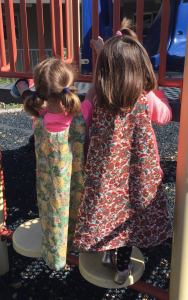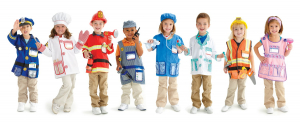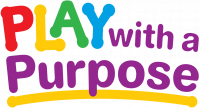“Bang, bang!” “Pshu, pshu!” “I’m shooting ice. You’re frozen!” These are common sounds and phrases spoken by young children in classrooms and on playgrounds throughout our country. Children’s play of shooting and battling is something we struggle with as teachers and parents. In the school I teach at, we have been confused about what is acceptable, and it has taken some research to understand that there is value in superhero dramatic play as long as there are rules that everyone respects.
Where does this play come from?
Children will dramatize superheroes, good versus evil, and war play through exposure to experiences from:
- Television
- Videogames
- Movies
- Toys
- Books
- Local and world news
- Family behaviors such as:
- Community service careers that utilize weapons
- Military
- Hunting
- Domestic violence
- Gang participation
- Criminal
I was thinking about the conversations that go on between adults that are overheard by children. We talk a lot about good people and bad people. We express anger and frustration at other human beings we don’t like or disagree with. Whether a politician, dictator, coach, or rude driver deserves vilification or not, our verbal and emotional reactions to other humans is what children see, hear, and try to understand. They have a lot to sort out in their minds when the adults in their lives are also teaching kindness, acceptance, and self-regulation!
The Value
 Children dramatize and creatively rework their life experiences, so these events make sense to them. This is one of the most important forms of play, and we encourage it through dramatic play centers. The good versus evil-type play has a strong value in providing opportunities for language and social skills, fine- and gross-motor development, and cognitive development through abstract thinking, problem solving, and perspective taking, to name just a few.
Children dramatize and creatively rework their life experiences, so these events make sense to them. This is one of the most important forms of play, and we encourage it through dramatic play centers. The good versus evil-type play has a strong value in providing opportunities for language and social skills, fine- and gross-motor development, and cognitive development through abstract thinking, problem solving, and perspective taking, to name just a few.
Some of these experiences are difficult for young children to understand and process, and dramatic play is an excellent outlet for them to work out those feelings associated with those tough experiences. By denying them this opportunity, we could be saying to them that what their police officer parent does for a living is bad, or their fears have no validity, AND we miss opportunities to help them with emotional struggles or concepts that are bigger than they are developmentally ready for. This last point is most important for teachers. Keep your eyes and ears on the play, and look for the teaching moments.
The Rules
All games come with rules and good guy/bad guy play needs rules that players and non-players understand. Ask children what they think the rules should be. How can we play “lasers” so everyone feels safe? Guide the children to these must-have rules:
- No person or property is harmed.
- Ask first if someone wants to play.
- Participants can tap out anytime, and the other players will respect their wish.
- Everyone must feel safe.
- If any of the above rules are not being followed, rules can be revisited, and teachers can change props or work with students to change rules.
Teacher’s Role
-
Provide parent education about screen time, content, and being involved in what is watched.
- Provide loose parts in the dramatic play area to promote creativity and open-ended opportunities. Also, educate parents about the value of loose parts (as opposed to a plastic, talking action figures with a back story).
- Listen to children’s conversations and watch their play.
- Intervene in children’s play to:
- Scaffold conflict resolution.
- If children are scared or getting hurt.
- Ask open-ended questions to promote a deeper thinking about their play and aid in elevating it prosocially.
- Provide opportunities to have children tell stories, sing songs, use puppetry, and do art to deal with issues of violence and conflict.
- Read stories about conflict resolution, feelings, sharing, peace, kindness, and real-life superheroes.
- Look at gun play as an opportunity to talk about gun safety (with parents too). We do fire drills, earthquake drills, lock in place drills, and what to do when we see matches and lighters—how about what to do when a child comes across a gun?
Create Your Policies and Procedures
For many, our initial instinct is to shut down all play that appears violent, but I encourage you to do your own research on its value and what can come from not allowing good guy-bad guy play. Next, consider your parent community and wider community, and make sure your policies are respectful to them. Each community has its own character and experiences that should be considered when formulating your policy. Then, set the play rules with the children and be intentional in creating an environment rich in experiences that support prosocial and emotional development.
Encourage your students with dramatic play!









Leave A Comment